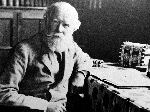The death of prehistory
I know this will upset many archaeologists but let’s admit it, prehistory is dead. Adding a pre- to history no longer makes any sense. Pre-history rightly belongs to the Jurassic’s dinosaurs and the wriggling worms of the Cambrian explosion; those shaley superstars Opabinia and Wiwaxia that Stephen Jay Gould trumpeted so loudly in Wonderful Life. Human prehistory deserves better than being lumped with big lizards and creatures with less neurons than an Arctic midge.
What to put in its place? Deep history is the obvious candidate. Deep in the sense of extremely ancient but also a human history told through stuff rather than through texts. The latter belongs to the realm of Shallow history; shallow only in time-depth not in methods or insights. Both histories need each other. Shallow history needs to understand the evolutionary drivers that account for human motivation and desire. It needs to see how engagement with stuff created the fabric of history. Deep history needs the inspiration of ethnography and the complex stories that emerged as societies intertwined at a global scale. Combined they provide a compelling story of humanity.

The big story from Deep history is a simple sound-bite: We are all Africans. The narratives of Shallow history are about two things that happened in the last 500 years; the documentation of human diversity that arose as we set out from Africa to become the only earth-wide species and the many reunions of humanity associated with that original global diaspora. And that’s the problem with human prehistory. It sets up a barrier, a break-point in what should be a seamless story of biology, culture and society told through the medium of stuff; bodies, books and beaker pottery.
2013 is the centenary of the death of John Lubbock, Lord Avebury. In a few days time we will all enjoy the Easter Bank Holiday, his gift as an MP to an over-worked Victorian world. As a boy Lubbock shared his love of beetles with his older neighbour Charles Darwin. His father-in-law, General Pitt-Rivers, became with his legislative help the first Inspector of Ancient Monuments for Britain. In 1865 the thirty-one year old Lubbock published Pre-Historic Times, As Illustrated by Ancient Remains, and the Manners and Customs of Modern Savages. He wasn’t the first to use the term but he certainly popularised it. This remarkable book with its hyphenated title has cast a long shadow. But it served its purpose long ago. We now know how to study the human past through the study of cultural and biological stuff drawn from locales, places and landscapes. So, could there be a more fitting centenary celebration for one of the giants of archaeology than to bury his creation, Pre-history, where it belongs – in the history books? Prehistory is dead, long live deep human history!
